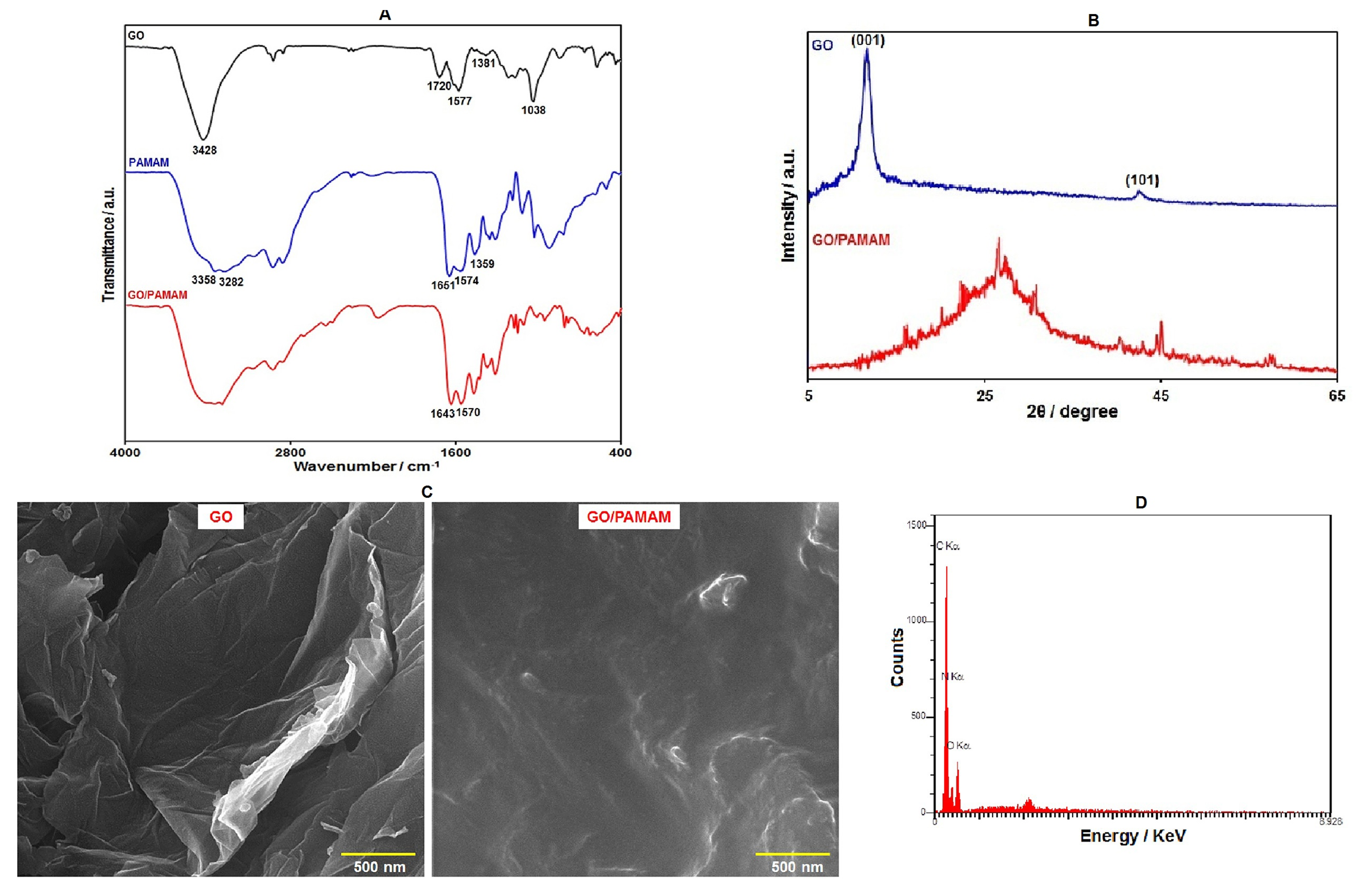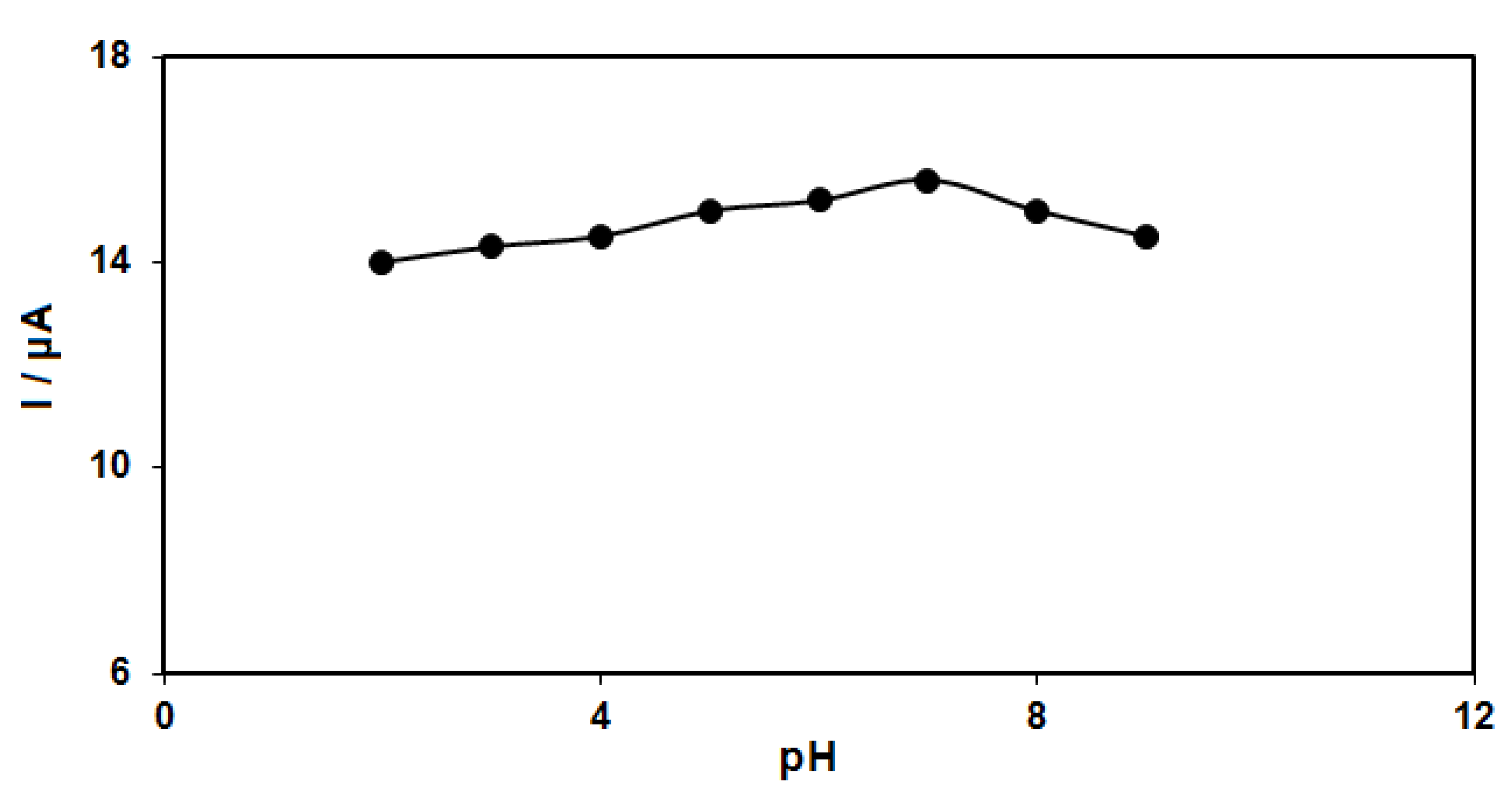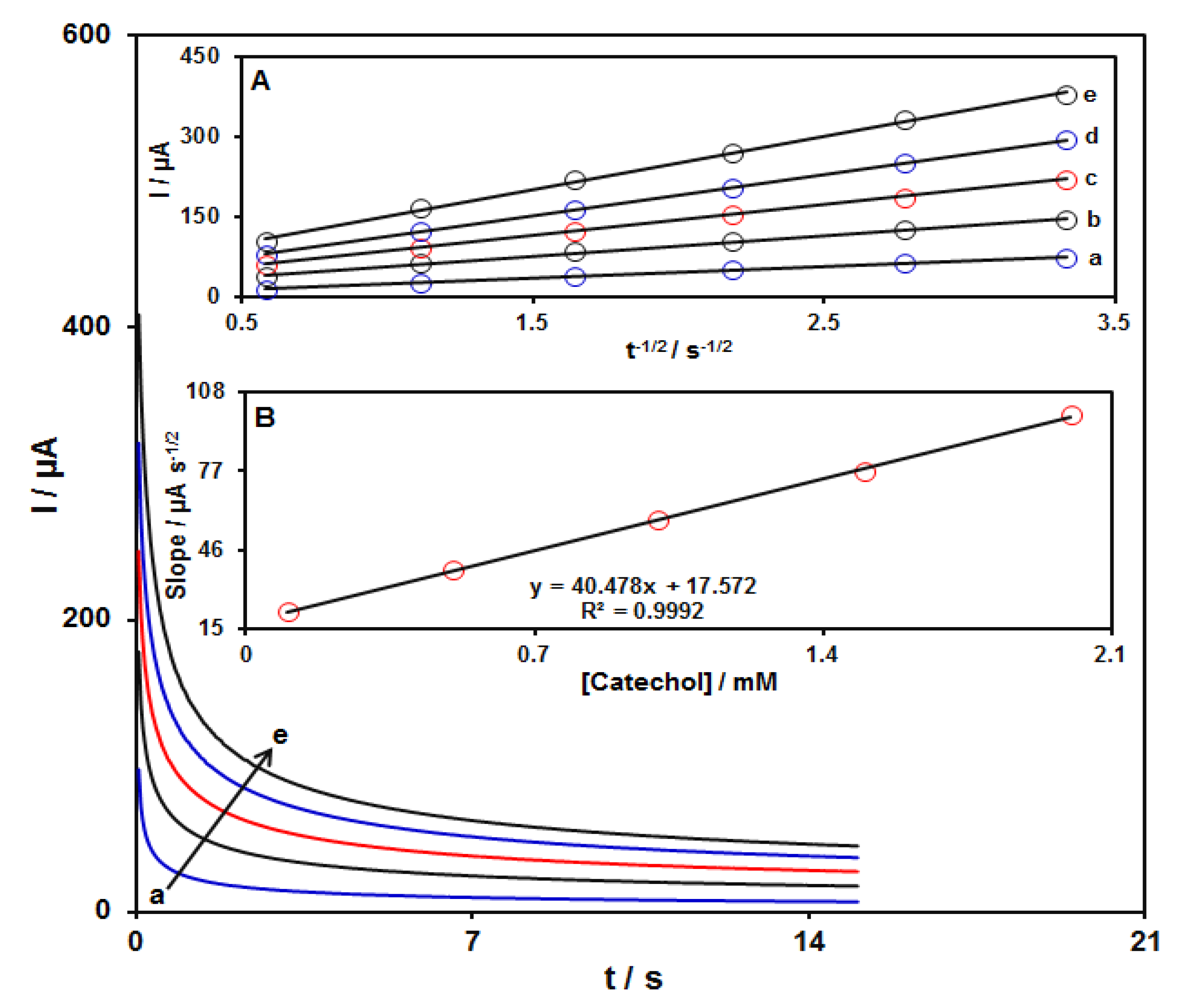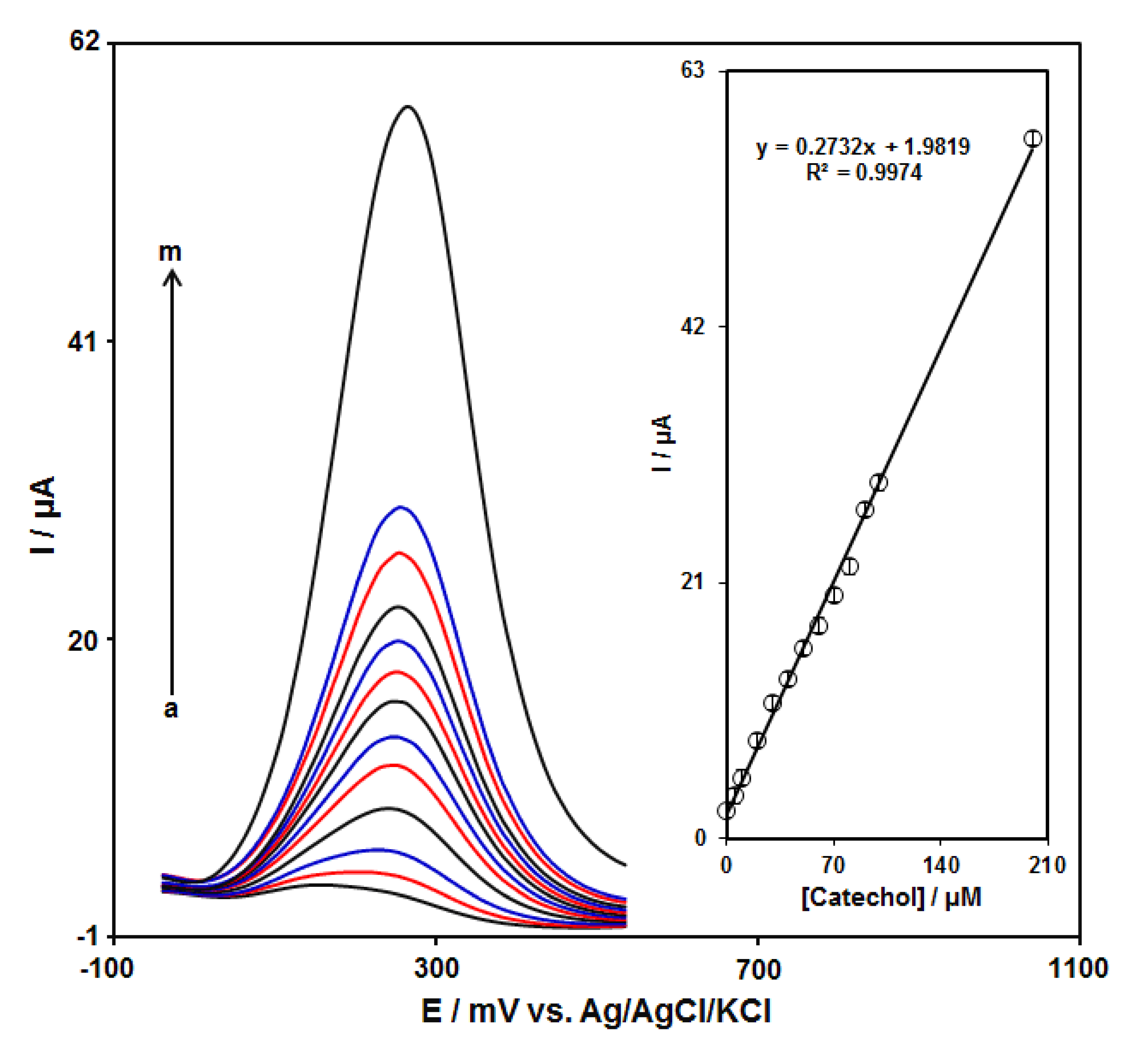Graphene Oxide–PAMAM Nanocomposite and Ionic Liquid Modified Carbon Paste Electrode: An Efficient Electrochemical Sensor for Simultaneous Determination of Catechol and Resorcinol
Abstract
:1. Introduction
2. Experimental
2.1. Laboratory Equipment and Chemicals
2.2. Synthesis of GO/G3–PAMAM Nanocomposite
2.3. Preparation of GO–PAMAM/ILCPE Sensor
2.4. Preparation of Water Specimens
3. Results and Discussion
3.1. Characterization of GO–PAMAM Nanocomposite
3.2. Comparison Study of Electrochemical Reaction of Catechol on Unmodified CPE and GO–PAMAM/ILCPE
3.3. Scan Rate Effect on Redox Reaction of Catechol at GO–PAMAM/ILCPE
3.4. Chronoamperometric Measurements
3.5. DPV Analysis of Catechol
3.6. DPV Analysis of Catechol in the Presence of Resorcinol
3.7. Selectivity of GO–PAMAM/ILCPE
3.8. Repeatability and Stability
3.9. Analytical Application
4. Conclusions
Author Contributions
Funding
Institutional Review Board Statement
Informed Consent Statement
Data Availability Statement
Conflicts of Interest
References
- Rao, H.; Liu, Y.; Zhong, J.; Zhang, Z.; Zhao, X.; Liu, X.; Wang, Y. Gold nanoparticle/chitosan@N,S co-doped multiwalled carbon nanotubes sensor: Fabrication, characterization, and electrochemical detection of catechol and nitrite. ACS Sustain. Chem. Eng. 2017, 5, 10926–10939. [Google Scholar] [CrossRef]
- Wang, J.; Park, J.N.; Wei, X.Y.; Lee, C.W. Room-temperature heterogeneous hydroxylation of phenol with hydrogen peroxide over Fe2+, Co2+ ion-exchanged Naβ zeolite. Chem. Commun. 2003, 3, 628–629. [Google Scholar] [CrossRef]
- Meng, S.; Hong, Y.; Dai, Z.; Huang, W.; Dong, X. Simultaneous detection of dihydroxybenzene isomers with ZnO nanorod/carbon cloth electrodes. ACS Appl. Mater. Interfaces 2017, 9, 12453–12460. [Google Scholar] [CrossRef]
- Yang, Y.; Wang, Q.; Qiu, W.; Guo, H.; Gao, F. Covalent immobilization of Cu3(btc)2 at chitosan–electroreduced graphene oxide hybrid film and its application for simultaneous detection of dihydroxybenzene isomers. J. Phys. Chem. C 2016, 120, 9794–9803. [Google Scholar] [CrossRef]
- Nagaraja, P.; Vasantha, R.A.; Sunitha, K.R. A new sensitive and selective spectrophotometric method for the determination of catechol derivatives and its pharmaceutical preparations. J. Pharm. Biomed. Anal. 2001, 25, 417–424. [Google Scholar] [CrossRef]
- Kovács, Á.; Mörtl, M.; Kende, A. Development and optimization of a method for the analysis of phenols and chlorophenols from aqueous samples by gas chromatography–mass spectrometry, after solid-phase extraction and trimethylsilylation. Microchem. J. 2011, 99, 125–131. [Google Scholar] [CrossRef]
- Lee, B.L.; Ong, H.Y.; Shi, C.Y.; Ong, C.N. Simultaneous determination of hydroquinone, catechol and phenol in urine using high-performance liquid chromatography with fluorimetric detection. J. Chromatogr. B Biomed. Sci. Appl. 1993, 619, 259–266. [Google Scholar] [CrossRef]
- Cui, H.; Zhang, Q.; Myint, A.; Ge, X.; Liu, L. Chemiluminescence of cerium (IV)–rhodamine 6G–phenolic compound system. J. Photochem. Photobiol. A Chem. 2006, 181, 238–245. [Google Scholar] [CrossRef]
- Li, S.; Li, X.; Xu, J.; Wei, X. Flow-injection chemiluminescence determination of polyphenols using luminol–NaIO4–gold nanoparticles system. Talanta 2008, 75, 32–37. [Google Scholar] [CrossRef]
- Pistonesi, M.F.; Di Nezio, M.S.; Centurión, M.E.; Palomeque, M.E.; Lista, A.G.; Band, B.S.F. Determination of phenol, resorcinol and hydroquinone in air samples by synchronous fluorescence using partial least-squares (PLS). Talanta 2006, 69, 1265–1268. [Google Scholar] [CrossRef]
- Kıranşan, K.D.; Topçu, E. Graphene paper with sharp-edged nanorods of Fe− CuMOF as an excellent electrode for the simultaneous detection of catechol and resorcinol. Electroanalysis 2019, 31, 2518–2529. [Google Scholar] [CrossRef]
- Manjunatha, J.G. A surfactant enhanced graphene paste electrode as an effective electrochemical sensor for the sensitive and simultaneous determination of catechol and resorcinol. Chem. Data Collect. 2020, 25, 100331. [Google Scholar] [CrossRef]
- Huang, L.; Cao, Y.; Diao, D. Electrochemical activation of graphene sheets embedded carbon films for high sensitivity simultaneous determination of hydroquinone, catechol and resorcinol. Sens. Actuators B Chem. 2020, 305, 127495. [Google Scholar] [CrossRef]
- Zhao, G.; Wang, X.; Liu, G.; Cao, Y.; Liu, N.; Thuy, N.T.D.; Yu, M. A flexible and disposable electrochemical sensor for the evaluation of arsenic levels: A new and efficient method for the batch fabrication of chemically modified electrodes. Anal. Chim. Acta 2022, 1194, 339413. [Google Scholar] [CrossRef]
- Raoof, J.B.; Ojani, R.; Beitollahi, H.; Hosseinzadeh, R. Electrocatalytic oxidation and highly selective voltammetric determination of L-cysteine at the surface of a 1-[4-(ferrocenyl ethynyl) phenyl]-1-ethanone modified carbon paste electrode. Anal. Sci. 2006, 22, 1213–1220. [Google Scholar] [CrossRef]
- Hosseini Fakhrabad, A.; Sanavi Khoshnood, R.; Abedi, M.R.; Ebrahimi, M. Fabrication a composite carbon paste electrodes (CPEs) modified with multi-wall carbon nano-tubes (MWCNTs/N,N-Bis (salicyliden)-1,3-propandiamine) for determination of lanthanum (III). Eurasian Chem. Commun. 2021, 3, 627–634. [Google Scholar]
- Karimi-Maleh, H.; Khataee, A.; Karimi, F.; Baghayeri, M.; Fu, L.; Rouhi, J.; Boukherroub, R. A green and sensitive guanine-based DNA biosensor for idarubicin anticancer monitoring in biological samples: A simple and fast strategy for control of health quality in chemotherapy procedure confirmed by docking investigation. Chemosphere 2022, 291, 132928. [Google Scholar] [CrossRef]
- Tajik, S.; Aflatoonian, M.R.; Beitollahi, H.; Sheikhshoaie, I.; Dourandish, Z.; Garkani-Nejad, F.; Bamorovat, M. Electrocatalytic oxidation and selective voltammetric detection of methyldopa in the presence of hydrochlorothiazide in real samples. Microchem. J. 2020, 158, 105182. [Google Scholar] [CrossRef]
- Feng, X.; Han, G.; Cai, J.; Wang, X. Au@Carbon quantum Dots-MXene nanocomposite as an electrochemical sensor for sensitive detection of nitrite. J. Colloid Interface Sci. 2022, 607, 1313–1322. [Google Scholar] [CrossRef]
- Karimi-Maleh, H.; Darabi, R.; Shabani-Nooshabadi, M.; Baghayeri, M.; Karimi, F.; Rouhi, J.; Karaman, C. Determination of D&C Red 33 and Patent Blue V Azo dyes using an impressive electrochemical sensor based on carbon paste electrode modified with ZIF-8/g-C3N4/Co and ionic liquid in mouthwash and toothpaste as real samples. Food Chem. Toxicol. 2022, 112, 112907. [Google Scholar]
- Sengar, M.; Saxena, S.; Satsangee, S.; Jain, R. Silver nanoparticles decorated functionalized multiwalled carbon nanotubes modified screen printed sensor for the voltammetric determination of butorphanol. J. Appl. Organomet. Chem. 2021, 1, 95–108. [Google Scholar]
- Yang, M.; Sun, Z.; Jin, H.; Gui, R. Sulfur nanoparticle-encapsulated MOF and boron nanosheet-ferrocene complex modified electrode platform for ratiometric electrochemical sensing of adriamycin and real-time monitoring of drug release. Microchem. J. 2022, 177, 107319. [Google Scholar] [CrossRef]
- Mazloum-Ardakani, M.; Beitollahi, H.; Ganjipour, B.; Naeimi, H. Novel carbon nanotube paste electrode for simultaneous determination of norepinephrine, uric acid and d-penicillamine. Int. J. Electrochem. Sci. 2010, 5, 531–546. [Google Scholar]
- Eren, T.; Atar, N.; Yola, M.L.; Karimi-Maleh, H. A sensitive molecularly imprinted polymer based quartz crystal microbalance nanosensor for selective determination of lovastatin in red yeast rice. Food Chem. 2015, 185, 430–436. [Google Scholar] [CrossRef]
- Liu, W.; Zhao, X.; Guo, Q.; Dai, Y.; Tan, J.; Wang, M.; Qi, Y. Preparation of electrochemical sensor based on the novel NiO quantum dots modified Cu/Cu2O 3D hybrid electrode and its application for non-enzymatic detection of glucose in serums and beverages. J. Alloys Compd. 2022, 895, 162573. [Google Scholar] [CrossRef]
- Tajik, S.; Dourandish, Z.; Garkani-Nejad, F.; Beitollahi, H.; Mohammadzadeh-Jahani, P.; Di Bartolomeo, A. Transition metal dichalcogenides: Synthesis and use in the development of electrochemical sensors and biosensors. Biosens. Bioelectron. 2022, 216, 114674. [Google Scholar] [CrossRef]
- Peyman, H.; Roshanfekr, H.; Babakhanian, A.; Jafari, H. PVC membrane electrode modified by lawson as synthetic derivative ionophore for determination of cadmium in alloy and wastewater. Chem. Methodol. 2021, 5, 446–453. [Google Scholar]
- Alavi-Tabari, S.A.; Khalilzadeh, M.A.; Karimi-Maleh, H. Simultaneous determination of doxorubicin and dasatinib as two breast anticancer drugs uses an amplified sensor with ionic liquid and ZnO nanoparticle. J. Electroanal. Chem. 2018, 811, 84–88. [Google Scholar] [CrossRef]
- Wang, S.; Pan, M.; Liu, K.; Xie, X.; Yang, J.; Hong, L.; Wang, S. A SiO2@MIP electrochemical sensor based on MWCNTs and AuNPs for highly sensitive and selective recognition and detection of dibutyl phthalate. Food Chem. 2022, 381, 132225. [Google Scholar] [CrossRef]
- Ghulam, A.N.; dos Santos, O.A.; Hazeem, L.; Pizzorno Backx, B.; Bououdina, M.; Bellucci, S. Graphene oxide (GO) materials—Applications and toxicity on living organisms and environment. J. Funct. Biomater. 2022, 13, 77. [Google Scholar] [CrossRef]
- Paisanpisuttisin, A.; Poonwattanapong, P.; Rakthabut, P.; Ariyasantichai, P.; Prasittichai, C.; Siriwatcharapiboon, W. Sensitive electrochemical sensor based on nickel/PDDA/reduced graphene oxide modified screen-printed carbon electrode for nitrite detection. RSC Adv. 2022, 12, 29491–29502. [Google Scholar] [CrossRef]
- Manjula, N.; Chen, S.M. One-pot synthesis of rod-shaped gadolinia doped zinc oxide decorated on graphene oxide composite as an efficient electrode material for isoprenaline sensor. Compos. B Eng. 2021, 211, 108631. [Google Scholar] [CrossRef]
- Garcia, S.M.; Wong, A.; Khan, S.; Sotomayor, M.D. A simple, sensitive and efficient electrochemical platform based on carbon paste electrode modified with Fe3O4@MIP and graphene oxide for folic acid determination in different matrices. Talanta 2021, 229, 122258. [Google Scholar] [CrossRef] [PubMed]
- Hashim, N.; Muda, Z.; Hussein, M.Z.; Isa, I.M.; Mohamed, A.; Kamari, A.; Jaafar, A. A brief review on recent graphene oxide-based material nanocomposites: Synthesis and applications. J. Mater. Environ. Sci. 2016, 7, 3225–3243. [Google Scholar]
- Yu, H.; Guo, W.; Lu, X.; Xu, H.; Yang, Q.; Tan, J.; Zhang, W. Reduced graphene oxide nanocomposite based electrochemical biosensors for monitoring foodborne pathogenic bacteria: A review. Food Control 2021, 127, 108117. [Google Scholar] [CrossRef]
- García-Gallego, S.; Franci, G.; Falanga, A.; Gómez, R.; Folliero, V.; Galdiero, S.; Galdiero, M. Function oriented molecular design: Dendrimers as novel antimicrobials. Molecules 2017, 22, 1581. [Google Scholar] [CrossRef] [PubMed]
- Shamsipur, M.; Tabrizi, M.A.; Mahkam, M.; Aboudi, J. A High Sensitive TNT Sensor Based on Electrochemically Reduced Graphene Oxide-Poly (amidoamine) Modified Electrode. Electroanalysis 2015, 27, 1466–1472. [Google Scholar] [CrossRef]
- Sánchez, A.; Villalonga, A.; Martínez-García, G.; Parrado, C.; Villalonga, R. Dendrimers as soft nanomaterials for electrochemical immunosensors. Nanomaterials 2019, 9, 1745. [Google Scholar] [CrossRef]
- Ghorbanizamani, F.; Timur, S. Ionic liquids from biocompatibility and electrochemical aspects toward applying in biosensing devices. Anal. Chem. 2018, 90, 640–648. [Google Scholar] [CrossRef]
- Seddon, K.R. Ionic liquids for clean technology. J. Chem. Technol. Biotechnol. 1997, 68, 351–356. [Google Scholar] [CrossRef]
- Zhao, H.; Xia, S.; Ma, P. Use of ionic liquids as ‘green’ solvents for extractions. J. Chem. Technol. Biotechnol. 2005, 80, 1089–1096. [Google Scholar] [CrossRef]
- Silvester, D.S. Recent advances in the use of ionic liquids for electrochemical sensing. Analyst 2011, 136, 4871–4882. [Google Scholar] [CrossRef]
- Zhao, H. Innovative applications of ionic liquids as “green” engineering liquids. Chem. Eng. Commun. 2006, 193, 1660–1677. [Google Scholar] [CrossRef]
- Sheldon, R. Catalytic reactions in ionic liquids. Chem. Commun. 2001, 23, 2399–2407. [Google Scholar] [CrossRef] [PubMed]
- Zhang, Q.; Cheng, W.; Wu, D.; Yang, Y.; Feng, X.; Gao, C.; Tang, X. An electrochemical method for determination of amaranth in drinks using functionalized graphene oxide/chitosan/ionic liquid nanocomposite supported nanoporous gold. Food Chem. 2022, 367, 130727. [Google Scholar] [CrossRef]
- Goodchild, S.A.; Hubble, L.J.; Mishra, R.K.; Li, Z.; Goud, K.Y.; Barfidokht, A.; Wang, J. Ionic liquid-modified disposable electrochemical sensor strip for analysis of fentanyl. Anal. Chem. 2019, 91, 3747–3753. [Google Scholar] [CrossRef]
- Garkani-Nejad, F.; Sheikhshoaie, I.; Beitollahi, H. Simultaneous detection of carmoisine and tartrazine in food samples using GO-Fe3O4-PAMAM and ionic liquid basefigd electrochemical sensor. Food Chem. Toxicol. 2022, 162, 112864. [Google Scholar] [CrossRef]
- Rafi, M.; Samiey, B.; Cheng, C.H. Study of adsorption mechanism of congo red on graphene oxide/PAMAM nanocomposite. Materials 2018, 11, 496. [Google Scholar] [CrossRef]
- Bard, A.J.; Faulkner, L.R. Fundamentals and applications. Electrochem. Methods 2001, 2, 580–632. [Google Scholar]







| Sample | Spiked (μM) | Found (μM) | Recovery (%) | R.S.D. (%) | ||||
|---|---|---|---|---|---|---|---|---|
| Catechol | Resorcinol | Catechol | Resorcinol | Catechol | Resorcinol | Catechol | Resorcinol | |
| Tap Water | 0 | 0 | - | - | - | - | - | - |
| 5.0 | 4.0 | 5.1 | 3.9 | 102.0 | 97.5 | 2.1 | 3.1 | |
| 7.0 | 6.0 | 6.8 | 6.2 | 97.1 | 103.3 | 3.6 | 2.2 | |
| 9.0 | 8.0 | 9.1 | 7.7 | 101.1 | 96.2 | 1.7 | 2.9 | |
| 11.0 | 10.0 | 10.9 | 10.1 | 99.1 | 101.0 | 2.4 | 1.9 | |
| Well Water | 0 | 0 | - | - | - | - | - | - |
| 4.5 | 5.5 | 4.6 | 5.3 | 102.2 | 96.4 | 3.0 | 2.3 | |
| 6.5 | 7.5 | 6.4 | 7.6 | 98.5 | 101.3 | 3.6 | 1.7 | |
| 8.5 | 9.5 | 8.6 | 9.3 | 101.2 | 97.9 | 2.4 | 3.2 | |
| 10.5 | 11.5 | 10.4 | 11.8 | 99.0 | 102.6 | 1.9 | 2.5 | |
Disclaimer/Publisher’s Note: The statements, opinions and data contained in all publications are solely those of the individual author(s) and contributor(s) and not of MDPI and/or the editor(s). MDPI and/or the editor(s) disclaim responsibility for any injury to people or property resulting from any ideas, methods, instructions or products referred to in the content. |
© 2023 by the authors. Licensee MDPI, Basel, Switzerland. This article is an open access article distributed under the terms and conditions of the Creative Commons Attribution (CC BY) license (https://creativecommons.org/licenses/by/4.0/).
Share and Cite
Garkani Nejad, F.; Beitollahi, H.; Sheikhshoaie, I. Graphene Oxide–PAMAM Nanocomposite and Ionic Liquid Modified Carbon Paste Electrode: An Efficient Electrochemical Sensor for Simultaneous Determination of Catechol and Resorcinol. Diagnostics 2023, 13, 632. https://doi.org/10.3390/diagnostics13040632
Garkani Nejad F, Beitollahi H, Sheikhshoaie I. Graphene Oxide–PAMAM Nanocomposite and Ionic Liquid Modified Carbon Paste Electrode: An Efficient Electrochemical Sensor for Simultaneous Determination of Catechol and Resorcinol. Diagnostics. 2023; 13(4):632. https://doi.org/10.3390/diagnostics13040632
Chicago/Turabian StyleGarkani Nejad, Fariba, Hadi Beitollahi, and Iran Sheikhshoaie. 2023. "Graphene Oxide–PAMAM Nanocomposite and Ionic Liquid Modified Carbon Paste Electrode: An Efficient Electrochemical Sensor for Simultaneous Determination of Catechol and Resorcinol" Diagnostics 13, no. 4: 632. https://doi.org/10.3390/diagnostics13040632
APA StyleGarkani Nejad, F., Beitollahi, H., & Sheikhshoaie, I. (2023). Graphene Oxide–PAMAM Nanocomposite and Ionic Liquid Modified Carbon Paste Electrode: An Efficient Electrochemical Sensor for Simultaneous Determination of Catechol and Resorcinol. Diagnostics, 13(4), 632. https://doi.org/10.3390/diagnostics13040632







